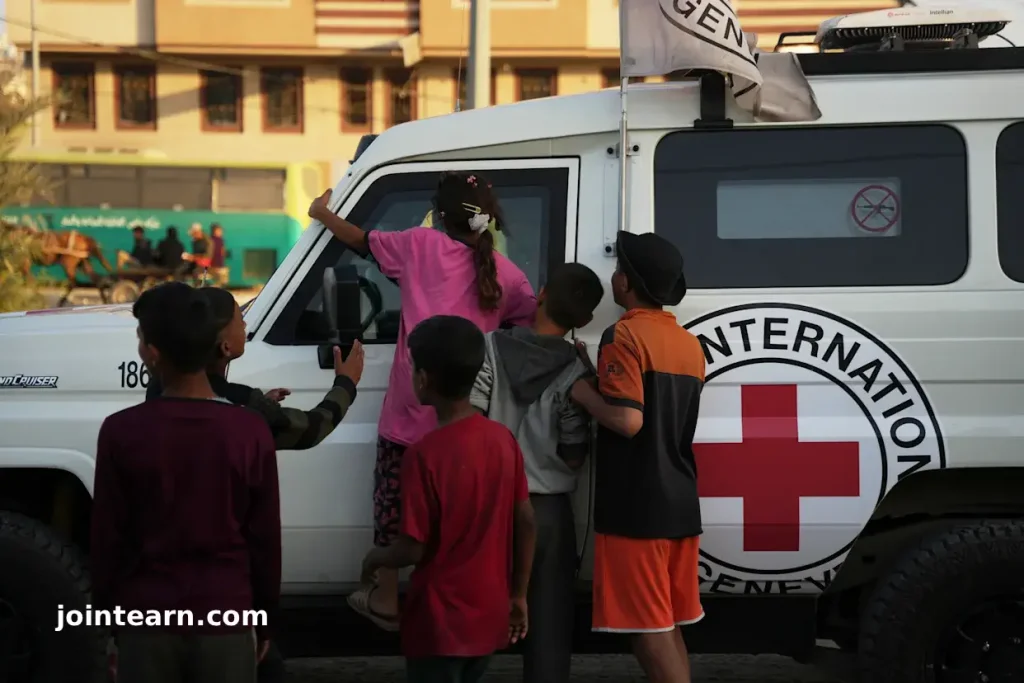
JERUSALEM — October 31, 2025 — The Israel-Hamas ceasefire showed signs of both progress and renewed strain on Thursday, as Palestinian militants handed over the remains of two Israeli hostages to the International Committee of the Red Cross (ICRC) in Gaza — even as Israeli airstrikes injured dozens across the southern part of the territory.
The Israeli military confirmed that the two sets of remains were transferred to Israeli forces through the Red Cross and later transported to the National Institute of Forensic Medicine for verification.
Prime Minister Benjamin Netanyahu’s office identified the victims as Sahar Baruch and Amiram Cooper, both taken hostage during the October 7, 2023 Hamas-led attack that ignited one of the deadliest wars in modern Middle East history.
Israel Confirms Hostage Identities
According to the Prime Minister’s statement, Hamas has now returned 17 hostages’ remains since the ceasefire took effect on October 10, 2025, with 11 more expected to be handed over under the agreement brokered by Egypt and Qatar.
In exchange, Israel has returned the bodies of 195 Palestinians to Gaza authorities. However, Israeli officials have not released information about their identities, and it remains unclear whether they were killed during the 2023 attack, died in custody, or were recovered from battle zones inside Gaza.
Health officials in Gaza said the identification process has been hindered by a lack of DNA testing kits and other forensic tools amid the ongoing humanitarian crisis.
Remembering the Hostages
Sahar Baruch, 25, was preparing to pursue an electrical engineering degree when militants abducted him from Kibbutz Be’eri. His brother, Idan, was killed during the same attack. Three months into his captivity, the Israeli military confirmed Baruch’s death during an unsuccessful rescue mission.
Amiram Cooper, 84, was a founding member of Kibbutz Nir Oz and a respected economist. He was taken hostage with his wife, Nurit, who was released after 17 days. Israeli authorities announced in June 2024 that Cooper had been killed while held in Gaza.
Renewed Strikes Amid Fragile Ceasefire
Despite the ongoing exchange of bodies, tensions flared overnight as Israeli airstrikes hit southern Gaza, injuring at least 40 people in Khan Younis, according to Mohammad Saar, head of the nursing department at Nasser Hospital. He confirmed that all the wounded were being treated at the already overcrowded medical center.
The Israeli Defense Forces (IDF) said the strikes targeted “terrorist infrastructure posing a threat to troops” in areas under Israeli control. Officials insisted that the operation did not violate the ceasefire but was necessary for “defensive enforcement” after Hamas militants allegedly fired on Israeli positions.
Netanyahu Issues Stern Warning to Hamas
Speaking at a military graduation ceremony in southern Israel on Thursday, Prime Minister Netanyahu warned that Israel would respond forcefully to any perceived ceasefire violations.
“If Hamas continues to blatantly violate the ceasefire, it will experience powerful strikes, as it did the day before yesterday and yesterday,” Netanyahu declared. “At the end of the day, Hamas will be disarmed and Gaza will be demilitarized. If foreign forces do this, all the better. And if they don’t, we will do it.”
His remarks came after a week of deadly clashes that left more than 100 Palestinians dead, prompting global concern that the ceasefire might collapse entirely.
Ceasefire Enforcement and U.S. Mediation
According to a senior U.S. official, intermediaries Egypt and Qatar informed Hamas on Wednesday that its fighters must withdraw from the so-called “yellow zone” — an area under Israeli control — within 24 hours or face new Israeli airstrikes. The deadline expired Thursday, after which, the official said, “Israel will enforce the ceasefire and engage Hamas targets behind the yellow line.”
The U.S. official, who spoke anonymously due to the sensitivity of the negotiations, described the situation as “delicate but still manageable,” noting that American diplomats are maintaining continuous contact with regional partners to prevent an all-out escalation.
Two Years of Devastation
The 2023 Hamas attacks that triggered the war left 1,200 Israelis dead and 251 people taken hostage, marking one of the darkest chapters in Israel’s history.
In the two years since, Israel’s military offensive has killed more than 68,600 Palestinians, according to Gaza’s Health Ministry, which does not distinguish between civilians and combatants. The ministry, which operates under Hamas administration but is staffed by medical professionals, maintains detailed casualty records that independent analysts view as credible.
Israel disputes these figures but has not provided an alternative toll. Critics, including some international human rights bodies, have accused Israel of collective punishment and disproportionate force, allegations that Israeli officials reject as politically motivated.
Humanitarian Strain and Diplomatic Efforts
Hospitals in Gaza, including Nasser Hospital and Al-Shifa, continue to face acute shortages of fuel, medicine, and surgical supplies. Doctors report that dozens of patients die daily from untreated wounds, infections, and malnutrition.
Meanwhile, Egyptian, Qatari, and U.S. mediators are trying to stabilize the truce, using the hostage and body exchanges as leverage for broader talks on Gaza’s reconstruction and the demilitarization of militant factions.
A Cairo-based mediator told Reuters that the ongoing exchanges “represent a fragile bridge of communication that must not be broken,” adding that “each name returned brings us one step closer to closure, but one strike can destroy weeks of diplomacy.”
Conclusion
The handover of two more hostages’ remains underscores both the human cost of the Gaza war and the fragile progress of ceasefire diplomacy. As Israel continues targeted operations and Hamas negotiates through intermediaries, the future of the truce — and the hope of lasting peace — hangs in a delicate balance.


Leave a Reply